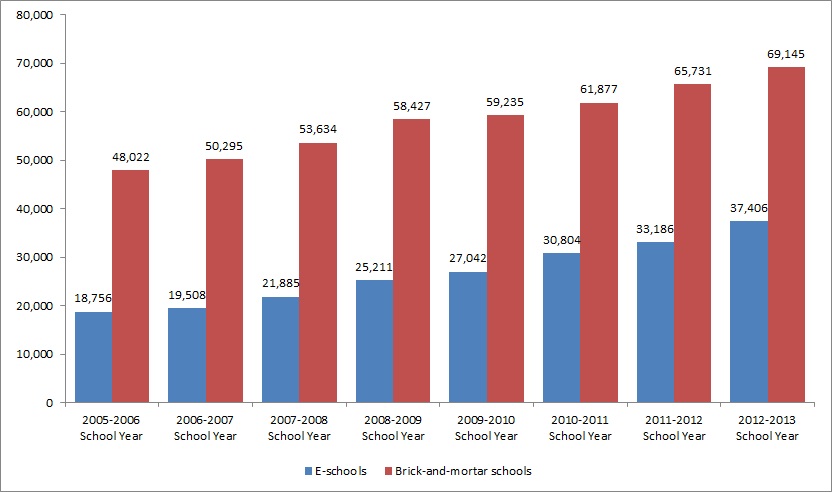Ohio’s charter-school enrollments have been climbing steadily during the past decade. Currently, approximately 120,000 students in Ohio attend a charter school, compared to 34,000 kids in charters just ten years ago (in the 2002–03 school year).
In recent years, however, e-schools have been the primary driver of charter growth. (E-schools are considered “charter schools” under state law.) Consider Chart 1, which shows the eight-year enrollment trend for students who attend a “start-up” charter school.[1] From 2005–06 to 2012–13, the percentage increase in e-school enrollment (up 99 percent) easily surpasses that of brick-and-mortar charters (up 44 percent). As a result, e-school enrollment has increased as a percentage of overall start-up charter-school enrollments: in 2006, e-schools accounted for 28 percent; in 2013, they accounted for 35 percent. The rise in e-school enrollment has occurred despite a statewide moratorium on new e-schools from 2005 to 2013.
Chart 1: Both e-school and brick-and-mortar charters have grown, with e-schools growing more quickly – Student enrollment in e-school and brick-and-mortar start-up charter schools, 2005–06 to 2012–13

Source: Ohio Department of Education
The explosive expansion of e-schools leaves me with a number of questions. Are e-schools high-quality education options? (The value-added scores of e-schools are abysmal, leaving doubts in my mind about their effectiveness.) Who is regulating, monitoring, managing, and governing these schools? (Try and find either the management team or the board of directors of ECOT on their website.) Why are parents selecting e-schools for their children? How long do they stay? Finally, what does the rapid rise of e-schools mean for the charter-school movement in general? Does being pro–charter schools also imply a pro-e-school stance? Why are e-schools considered charter schools in the first place--and must they be organized as a "charter"?
With regard to school choice in Ohio, online schools are the elephant in the room. On the one hand, technology is great for education: MOOCs, blended learning, Khan Academy, and other digital forms of learning have boundless potential to transform K–12 education. New technology can unlock new efficiencies, methods of learning, and ways of organizing a classroom. On the other hand, color me skeptical as to whether a child’s education is best experienced wholly or mostly online. Maybe I’m old-fashioned and still believe in the value of a human delivering a lesson and providing personal guidance, help, and feedback. So for now, I’ll take the distinction of being pro-charter (and quality ones, for sure), but at the same time, I’ll remain an e-school-charter skeptic. In Ohio, I suppose that puts me in an increasingly tenuous position.
[1] A small fraction of charter students—less than one in ten—attend a “conversion” charter school. These schools, considered “charters” by law, are authorized by either a traditional district or a regional Educational Service Center. They have tended to be dropout-recovery schools or locally run virtual schools.

